List of extinct dog breeds
List of extinct dog breeds, varieties and types
| Name | Image | Notes |
|---|---|---|
| Alaunt | 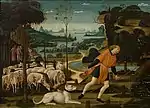 |
Large running dogs used during the Middle Ages to seize and bring down game for the hunter to dispatch; they were described as having the body of a greyhound with a broad and short brachycephalic-type head.[1] |
| Alpine Mastiff |  |
A mastiff-type dog known in the Western Alps from the Middle Ages, it is sometimes claimed they were descended from dogs introduced to the area by the Romans; a short-haired dog that is believed to be the progenitor of the St. Bernard.[2] |
| Argentine Polar Dog |  |
A variety of sled dog that was developed by the Argentine Army from the 1950s to equip its bases in Antarctica with a means of transport; it became extinct in the early 1990s when sled dogs were removed from Antarctica to comply with the Scientific Committee for Antarctic Research regulations.[3] |
| Belgian Mastiff | 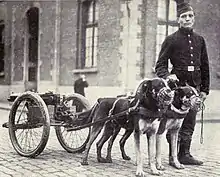 |
A breed of mastiff that was used throughout the Low Countries as a draught animal, it was a large, powerful dog with a smooth coat and docked tail; its role became redundant in the 20th century and it is believed to be extinct.[4] |
| Black and Tan Terrier | 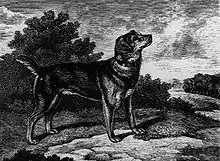 |
A British breed of terrier that was common throughout all of Great Britain, it had a rough coat that was black and tan in colour; most of the fell terrier breeds, including the Border Terrier, Lakeland Terrier and Welsh Terrier, descend from it.[5] |
| Blue Paul Terrier | A British breed of bull-type terrier from Scotland used for dog fighting; popular from the mid-19th century, it disappeared at the end of the century with the criminalisation of dog fighting.[6] | |
| Braque Dupuy | 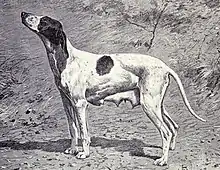 |
A French breed of pointer from the Poitou region; known for its pace compared to other French pointing breeds, it was sometimes claimed Greyhound or Sloughi blood was used in their breeding.[7] |
| Bull and terrier | 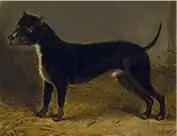 |
The original bull-type terrier, this British breed was bred in England by crossing the Old English Bulldog with the Black and Tan Terrier for the purpose of dog fighting; many consider the Staffordshire Bull Terrier to be the same dog with a modern name.[8] |
| Bullenbeisser | 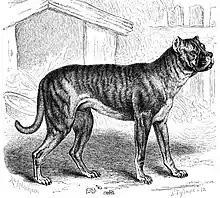 |
A German hunting-mastiff known from the Middle Ages, used to hunt stag, boar and even bear; it is considered the progenitor of the Boxer.[9] |
| Chien-gris | 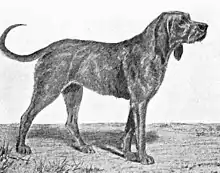 |
A French breed of scenthound known in the Middle Ages, it was said to have been introduced to France from the east by King Louis IX returning from the Crusades.[10] |
| Chiribaya Dog | A herding breed developed by the Chiribaya culture of southwestern Peru.[11][12] | |
| Cordoba Fighting Dog |  |
A fighting breed developed in Córdoba, Argentina,[13] and an ancestor of the Dogo Argentino.[14] |
| Cumberland Sheepdog | A British herding dog from Cumberland that was very similar to the Border Collie; its numbers declined from the mid-20th century.[15] | |
| Cur | 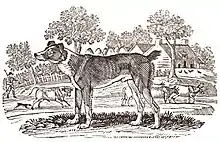 |
A British breed of herding dog used by cattle drovers in England, it was known for its distinctive stumpy tail; it likely became extinct in the mid-19th century.[16] |
| Dalbo dog |  |
|
| Dogo Cubano | 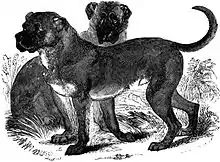 |
A Cuban breed of mastiff originally used for bull-baiting; believed to have been descended from introduced Spanish mastiffs, they became extinct in the mid-20th century.[17] |
| Dumfriesshire Black and Tan Foxhound | A British pack of foxhounds from Scotland bred in the interwar period; a combination of English Foxhound, Welsh Foxhound, Bloodhound and Gascon Saintongeois blood, they were a unique, black and tan coloured pack; the pack was disbanded after foxhunting was banned in 2002.[18] | |
| English Water Spaniel | 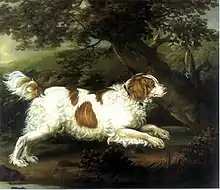 |
A British breed of gundog that in appearance was described as being between a spaniel and a retriever in appearance; very popular with wildfowlers in the mid-19th century, it is considered the progenitor of both the Curly-Coated Retriever and the Flat-Coated Retriever (which supplanted it in popularity) and it disappeared around the end of the 19th century.[19] |
| English White Terrier | 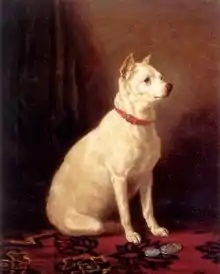 |
A British breed of terrier from England that was all-white in appearance; it was the progenitor of the Fox Terrier and one of several of the Bull Terrier.[20] |
| Fila da Terceira |  |
A mastiff-type dog from the Azores,[21]it was the ancestor of the Saint Miguel Cattle Dog and the Fila Brasileiro. |
| Fuegian dog | .jpg.webp) |
A domesticated form of the culpeo (Lycalopex culpaeus).[22] |
| Grand Fauve de Bretagne | 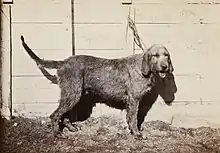 |
A French breed of scenthound from Brittany that was used to hunt wolves and wild boar; the breed became extinct in the late 19th century after the extirpation of wolves from much of France.[10] |
| Halls Heeler | 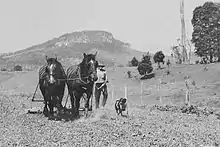 |
An Australian breed of cattle herding dog bred from imported Scotch collies crossed with dingos; it is claimed they were the progenitor of the Australian Cattle Dog.[23] |
| Hare Indian Dog | 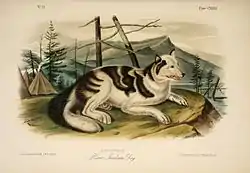 |
|
| Hawaiian Poi Dog | .jpg.webp) |
A Hawaiian pye-dog that was kept by the native Hawaiians before European settlement; the Poi Dog was kept as both a pet and for human consumption, it also played a ceremonial role in Hawaiian culture; taking its name from poi, which was its main diet, it became extinct after the introduction of European dog breeds to the islands.[24] |
| Kurī | 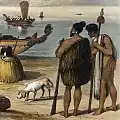 |
|
| Lapponian Shepherd | ||
| Limer | 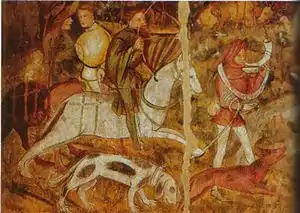 |
A scenthound in the Middle Ages used to locate a stag on the morning of a stag hunt, the limer was kept on a leash and led the huntsman to the stag, which was subsequently hunted by other hound types; limers were known for their scenting ability and had to work silently to avoid alerting the quarry.[25] |
| Marquesan Dog | .jpg.webp) |
|
| Molossus | 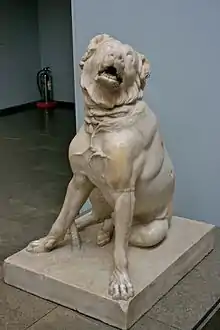 |
Large dogs kept in the ancient kingdom of Molossis in the region of Epirus; it is claimed they are the progenitors of the mastiffs.[26] |
| Moscow Water Dog | ||
| Norfolk Spaniel | 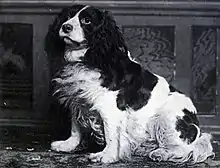 |
|
| North Country Beagle | .png.webp) |
A British medium-sized scenthound that was used to hunt hare, it was said to be smaller, with a sharper nose and faster than the contemporary Southern Hound; it is believed to be one of the foundation breeds of the modern English Foxhound.[27] |
| Old Croatian Sighthound | A Croatian breed of sighthound used to course all forms of local game; they were known from the Middle Ages.[28] | |
| Old English Bulldog | 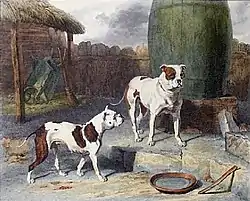 |
A British breed of specialised small mastiff-type dogs developed from the 16th century for the blood sport of bull-baiting; the prohibition of most blood sports in 1835 saw the decline of the breed, although some were retained as companion dogs and were bred into the modern Bulldog.[29] |
| Old Spanish Pointer | 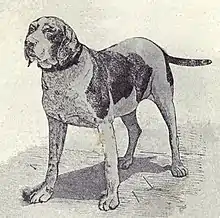 |
A breed of Spanish pointing dog known from the early modern period; it is considered the first of its type from which all modern pointing dog breeds descend.[30] |
| Paisley Terrier | 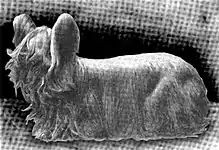 |
|
| Polynesian Dog | ||
| Rache |  |
A British type of hound in the Middle Ages, they were a fast-running scenthound used to drive game.[31] |
| Rastreador Brasileiro | 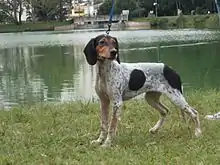 |
|
| Russian Tracker | 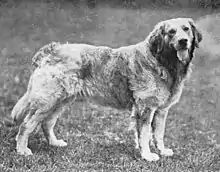 |
|
| St John's water dog |  |
A Canadian breed used by the fishermen of Newfoundland and Labrador; descended from imported European dogs brought to the New World on fishing vessels, it is considered the progenitor of the Labrador Retriever.[32] |
| Sakhalin Husky | 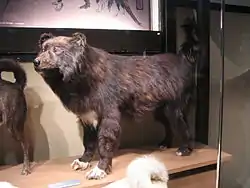 |
|
| Salish Wool Dog | .jpg.webp) |
|
| Sleuth hound | ||
| Southern Hound | 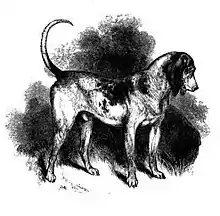 |
A British medium-sized scenthound that was used for hare hunting; a slow-paced, deep-scenting hound believed to be related to the Bloodhound, they became extinct towards the end of the 18th century when faster hounds became more popular for hare hunting.[33] |
| Tahitian Dog | .jpg.webp) |
|
| Tahltan Bear Dog | 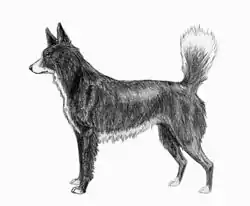 |
|
| Talbot Hound | 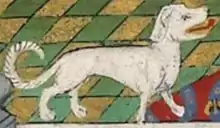 |
A British small to medium-sized white scenthound known from the Late Middle Ages; famed for its scenting ability, it was often employed pursuing criminals; it is believed to be a progenitor of the modern Bloodhound.[34] |
| Tesem |  |
|
| Toy Bulldog | 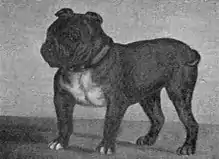 |
A British breed that was a miniaturised version of the Bulldog, it was popular in the late Victorian era as a companion dog; it is considered the progenitor of the French Bulldog (which supplanted it in popularity) and the last record of it was in 1914.[35] |
| Toy Trawler Spaniel | 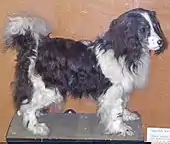 |
|
| Turnspit dog | 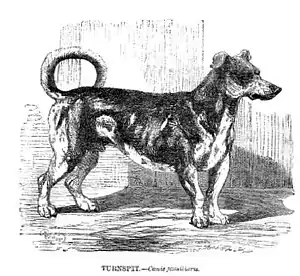 |
A British breed used in larger kitchens to run in a wheel that turned a rotisserie; these short-legged dogs were known from the Middle Ages, they likely became extinct in the 19th century.[36] |
| Tweed Water Spaniel | 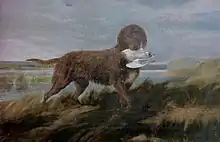 |
A British breed of gundog from the Anglo-Scottish border region; it was used by wildfowlers and is considered a progenitor of the Golden Retriever.[37] |
| Welsh Hillman | A British breed of herding dog from Wales.[38] |
References
Citations
- Cummins (2001), p. 14.
- Fogle (2009), p. 257.
- Maida (2015).
- Morris (2001), p. 666.
- Hancock (1984), p. 13.
- Morris (2001), pp. 348-349.
- Morris (2001), pp. 255-257.
- Morris (2001), p. 346.
- Fiorone (1973), p. 89.
- Hörter (2014).
- Collyns, Dan (September 23, 2006). "Mummified dogs uncovered in Peru". BBC News. Lima. Retrieved October 8, 2015.
- Leonard, Jennifer A.; et al. (2002-11-22). "Ancient DNA evidence for Old World Origin of New World Dogs". Science. 298 (5598): 1613–1616. Bibcode:2002Sci...298.1613L. doi:10.1126/science.1076980. PMID 12446908. S2CID 37190220.
- Mulkeen, Verity (11 May 2009). "Amores Perros: Dog Fighting in Argentina". The Argentina Independent. Archived from the original on 2013-06-17.
- Larry Levin (2010). Oogy: The Dog Only a Family Could Love. Grand Central Publishing. p. 67. ISBN 978-0-446-57487-7.
- Morris (2001), p. 408.
- Morris (2001), pp. 459-460.
- Morris (2001), pp. 369-370.
- Hancock (2014b), p. 45.
- Hancock (2013), pp. 138-142.
- Hancock (1984), pp. 13-15.
- Krämer, E.-M. (2009). Der grosse Kosmos Hundeführer, 229. Kosmos: Stuttgart.
- Petrigh, Romina S.; Fugassa, Martin H. (December 13, 2013). "Molecular identification of a Fuegian dog belonging to the Fagnano Regional Museum ethnographic collection, Tierra del Fuego" (PDF). Quaternary International. 317: 14–18. doi:10.1016/j.quaint.2013.07.030. Archived from the original (PDF) on December 20, 2016. Retrieved September 2, 2020.
- Hörter (2006).
- Wilcox & Walkowicz (1995), pp. 494-495.
- Cummins (2001), p. 22.
- Hancock (2001).
- Hancock (2014b), pp. 62-64.
- Morris (2001), p. 32.
- Morris (2001), pp. 342-343.
- Fogle (2009), p. 186.
- Cummins (2001), pp. 12 & 60-61.
- Hancock (2013), pp. 92-94.
- Alderton (2000), pp. 58-59.
- Alderton (2000), pp. 41 & 88.
- Morris (2001), pp. 507-508.
- Morris (2001), p. 578.
- Hancock (2013), pp. 36 & 50.
- Hancock (2014a), p. 11.
Bibliography
- Alderton, David (2000). Hounds of the world. Shrewsbury: Swan Hill Press. ISBN 1-85310-912-6.
- Cummins, John (2001). The hound and the hawk: the art of medieval hunting. London: Phoenix Press. ISBN 1-84212-097-2.
- Fiorone, Fiorenzo (1973). The encyclopedia of dogs: the canine breeds. New York: Thomas Y. Cromwell Company. ISBN 0-690-00056-1.
- Fogle, Bruce (2009). The encyclopedia of the dog. New York: DK Publishing. ISBN 978-0-7566-6004-8.
- Hancock, David (2014a). Dogs of the shepherds: a review of the pastoral breeds. Ramsbury, Wiltshire: The Crowood Press Ltd. ISBN 978-1-84797-808-0.
- Hancock, David (2013). Gundogs: their past, their performance and their prospects. Ramsbury, Marlborough: The Crowood Press Ltd. ISBN 978-1-84797-492-1.
- Hancock, David (2014b). Hounds: hunting by scent. Ramsbury, Marlborough: The Crowood Press Ltd. ISBN 978-1-84797-601-7.
- Hancock, David (1984). Old working dogs. Botley, Oxfordshire: Shire Publications Ltd. ISBN 0852636784.
- Hancock, David (2001). The mastiffs: the big game hunters: their history, development and future. Ducklington: Charwynne Dog Features. ISBN 9780951780114.
- Hörter, Rea (September 2006). "Dogs down under: the Australian breeds Part 2" (PDF). Dogs in Canada. Apex Publishing. pp. 47–53. Retrieved 13 October 2020.
- Hörter, Rea (May 2014). "Old French Hounds" (PDF). Canine Chronicle. Ocala, Florida: Endeavor Publications. pp. 250–256. Retrieved 4 June 2020.
- Maida, Juan Carlos (2015). "Breve historia del Perro Polar Argentino" [Brief history of the Argentine Polar Dog] (PDF). Revista de Medicina Veterinaria (in Spanish). 96 (2): 15–18. ISSN 1852-771X. Retrieved 1 December 2020.
- Morris, Desmond (2001). Dogs: the ultimate guide to over 1,000 dog breeds. North Pomfret, Vermont: Trafalgar Square Publishing. ISBN 1-57076-219-8.
- Wilcox, Bonnie; Walkowicz, Chris (1995). Atlas of dog breeds of the world. Neptune City, New Jersey: TFH Publications.
This article is issued from Wikipedia. The text is licensed under Creative Commons - Attribution - Sharealike. Additional terms may apply for the media files.